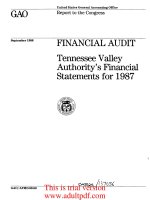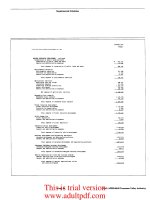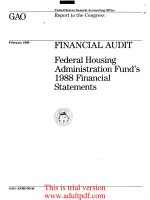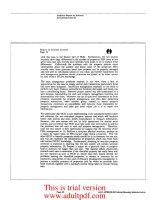United States General Accounting Office Report to the Congress _part4 pot
Bạn đang xem bản rút gọn của tài liệu. Xem và tải ngay bản đầy đủ của tài liệu tại đây (918.86 KB, 14 trang )
B-250977
Because
IRS'
assurance statement is not sufficiently comprehensive in its
assessment of IRS’ internal control and accounting systems, neither IRS nor
Treasury could understand the severity of these weaknesses, or provide
the attention needed to ensure that long-standing problems are corrected.
Similarly, without adequate disclosure, the President, the Congress, and
the public will likewise be unaware of the extent of IRS’ weaknesses and
the efforts needed to correct them.
As a result of our recommendations, IRS placed responsibility for the FMJ?IA
program under the Office of Management Controls within the Chief
Financial Officer’s organization and established a Senior Council for
Management Controls to oversee the program. Although IRS added the
material weaknesses we reported for 1992 to its 1993 report, it is still in
the process of developing adequate training and guidance needed to
effectively identify all internal control and accounting system wealmesses.
Conclusions
IRS remains vulnerable to critical financial management weaknesses that
expose it to lost revenue, errors in taxpayer balances, and lack of adequate
management of operating funds. Further, it still lacks supporting
information
for certain financial statement amounts, and has not been able
to properly analyze and record certain types of transactions. IRS needs to
improve the adequacy and reliability of its information to effectively
pursue its mission.
Although IRS is taking steps to improve its financial management to better
accomplish its mission, many are long-term efforts that will require
sustained attention to succeed. As a result, their benefits are not likely to
be realized for several years.
Recommendations
In the short term,
IRS
management should implement and monitor basic
control procedures, such as reconciliations and supervisory approval, to
ensure that cash and other assets are properly managed and accounted
for. These steps must be taken before meaningful information can be
obtained to assist IRS, Treasury,
OMB,
and the Congress in making informed
decisions. IRS must also implement long-term actions to address remaining
weaknesses. We reaftirm the recommendations resulting from our audit of
IRs’ fiscal year 1992 financial statements regarding controls over revenue,
accounts receivable, property and equipment, management of operating
funds, computer controls, seized assets, and reports required by FMFIA.
Page42 GAOL4IMD-94-120IES'FiscalYear1993FhancialStatementa
This is trial version
www.adultpdf.com
B-269977
These recommendations and the status of IRS’ responses are summarized
in appendix I.
We also are making the following new recommendations as a result of our
fiscal year 1993 audit.
Tax Collection Activities
We recommend that the Commissioner direct the Chief Financial Officer
to
.
ensure that
system
development efforts provide reliable, complete, timely,
and comprehensive information with which to evaluate the effectiveness
of its enforcement and collection programs;
.
establish and implement procedures to analyze the impact of abatements
on the effectiveness of assessments from IRS’ various collection programs;
and
l
reconcile detailed revenue transactions for individual taxpayers to the
master file and general iedger.
We also recommend that the Commissioner direct the Chief of Taxpayer
Services to establish and implement procedures to proactively identify
errors that occur during processing of data, and design and implement
improved systems and controls to prevent or detect such errors in the
future.
Management of Operating
We recommend that the Commissioner direct the Chief F’inancial Officer
Funds
to establish, for the CJX organization, a method to
l
monitor its systems and controls to regularly identify problems as they
occur by establishing clear lines of responsibility and communication from
top management to the lowest staff levels,
. develop action plans that are agreed upon by all affected groups and
individuals to correct problems identified, and
. continuously monitor corrective actions to ensure that progress is
achieved.
Further, we recommend that the Commissioner direct the Chief Financial
Officer to
. periodically compare information in payroll records to supporting
personnel information,
Page 43
GAWAIMD-94120 IRS’ Fhcnl Year 1993 Financial Statemente
This is trial version
www.adultpdf.com
B-269977
9 use
current
information to
periodically update estimated
future TSM costs,
and
l
develop reliable detailed information supporting its reported accounts
payable balances.
Seized Assets
We recommend that the Commissioner direct the Chief Financial Officer
to do the following:
I Develop and implement systems and standard operating procedures that
incorporate controls to ensure that seized asset inventory records are
accurately maintained, which include
9 establishing specific procedures to ensure the prompt and accurate
recording of seizures and disposals, including guidance addressing the
valuation of seized assets;
9 reconciling accounting and inventory records monthly as a.n interim
measure until the successful integration of inventory and accounting
systems is completed; and
9 implementing mechanisms for ensuring that annual physical inventories
at field locations are effectively performed, that discrepancies are
properly resolved, and that inventory records are appropriately
adjusted.
l
Determine what information related to seized assets, such as proceeds and
liens and other encumbrances, would be most useful to
IRS
managers for
financial management purposes and develop a means for accounting for
these data
Agency Comments
and Our Evaluation
In commenting on a draft of this report,
IRS
agreed with our
recommendations and stated that it plans to take action to address the
noted deficiencies in its systems and procedures.
IRS also
stated that it has
already implemented or planned corrective actions in response to our
fiscal year 1992 report, many of which are identified in this report. In
addition,
IRS
stated that it is committed to the goals of the
CFO
Act to
improve 6nancia.l management and to provide stakeholders and managers
with accurate and timely financial information.
In closing, we commend the Commissioner and TRS for its second-year
effort to develop reliable financial statements. We believe that although a
great many challenges still remain,
IRS'
progress to date represents a
Page 44
GAOIAIMD-94-120 IRS Fiscal Year 1993 Financial Statements
This is trial version
www.adultpdf.com
B-250977
significant contribution toward the
CFO
Act’s ultimate goal of improving
financial management throughout the federal government.
Charles A, Bowsher
Comptroller General
of the United States
April 30,1994
Page46
This is trial version
www.adultpdf.com
Financial Statements
Department of the Treasury
l
Internal Revenue Service
llltmmml
R-
Suuko
Chief Financial Officer’s
Annual Report
.
Fiscal Year 1993
Page 46
GANAIMD-94-120 185’ Fiscal Year 1999 FinancIaI Statements
This is trial version
www.adultpdf.com
Financial Statements
INTERNAL REVENUE SERVICE
Selected Financial and Operating Data
for the Fiscal Years Ended September 3@,1993 and 1992
SBLECTED FINANCUL AND OPERATING DATA (in thousands) 1993
1992
92 to 93
Number of Returns filed
207,423 2wo75
3.348
Revenue Colle~led $1,176a,SZ2,056 $1.121.110558 $55,411,4%
I
Refunds F%.xsed 83,679 89.272
G.593)
Refunds IWd
$103,009$71
S113,108.327 (S10.098.756)
Number of Returns Examined
Additmnal Tax and Penalties Recommended Aher Exammation
mo
1,452
(152)
w,080,361
126.932.179
($3.851.818)
Number of Installment Agreements
3,946
2504
1,442
Taxpayen Assisted 77,oOa 79,300
(2.303)
I
Collections and Operating Costs
I
* Operating Coot
lrn-
1983-1993
(DoBars in Bilkn)
u3 84 05
85 87 98
39 90
91 82 83
COLLECTED REVENUE HAS GROWN BY 88% OR $550 BIL.UON FROM 19S3 TO I993
WflU: CQSTS HAVE REMAINE# AT AN AVERAGE OF LESS THAN 1% OF COLLECi-TONS
Page 47
GAOIAIMD-94-120 IRS’ Fiscal Year 1993 Financial Statements
This is trial version
www.adultpdf.com
Financial Statements
C
bvewiew to the Financial Statements
Internal Revenue Service
Overview to the Financial
Statements
for
the
Fiscal Years Ended September 30, 1993 and 1992
Won
The purpose of the Internal Revenue Service is to collect the proper amount of
tax revenue at the least cost; serve the public by continually
impmving the
quality
of our products and services; and perform in a manner warranting the highest
degree of public confidence in our integrity, efficiency and fairness. We pursue
our mission by:
l
Increasing Voluntary Compliance
l
Reducing Burden on Taxpayers
l
Improving Quality-Driven Productivity and Customer Satisfaction
This report discusses IRS’s accomplishments in fiscal year 1993 and the
continuing challenges we face as we begin to reinvent the way we do business.
Objectives
The Service’s objectives are comprehensive long range goals describing what we
want to do to accomplish our mission.
Increase Voluntary Complllnce
The public’s willingness to meet its tax responsibility is the foundation of our
American tax system. Ensuring greater voluntary compliance is the most efficient
and cost-effective approach to collecting the revenues needed to fund America.
Most citizens want to comply with the tax laws.
It is our role to assist them in
understanding how to meet their tax obligations. We must ensure that the way
all of us in IRS administer the tax laws encourages compliance. and that we treat
the public with dignity and respect. It is essential then that we enforce the tax
laws vigilantly and vigorously against those who intentionally disregard their
responsibilities, in order to guatantee that all taxpayers pay their fair share.
Reduce Burden on Taxpayers
Taxpayer burden is the time, expense and dissatisfactioa experienced by
taxpayers, tax professionals and others in complying with the tax laws. Because
all Service employees have a role in administering these laws, reducing burden
tequires the commitment of everyone in IRS. The daily interaction our
employees have with taxpayers makes them particularly well qualified to identify
areas where burden is a problem, develop new approaches for reducing burden
and make burden reduction a consideration in all IRS decisions.
Improve Quality-Driven
Productivity ad
Customer Satisfaction
Improving the way we do business will minimize the burden on taxpayers and
costs of administeting the tax system. We will satisfy au customers’ needs by
providing quality products aad services that enable and encourage them to meet
their obligations. We must reduce the amount of time it takes to answer their
questions and resoIve their tax account problems. We must alao ensure that they
need
uwrtact us only once to get the help they request. To successfully meet
these challenges, we must create new ways of doing our work so that we become
more efftcient and effective. Our employees are the Service’s most valuable asset
and the key to identifying these new ways of doing our work and ensuring total
customer satisfaction.
Page 48
GAWAIMD-94-120 IRS’ Fiscal Year 1993 Financial Statements
This is trial version
www.adultpdf.com
Financial Statements
INTERNAL REVFNUE SERVICE
Overview to Financial
Statements
for the
Fiscal Years Ended
September 30,1993
and 1992
SiTUChl~
and
opentlons
As of fiscal year end, on-rolls staffing reached !X’,866 full-time, permanent
employees while other than full-time permanent levels Iotaled 13,395. The
Service’s operations are primarily conducted at the following locations:
l
National Office - Washington, DC.
Develops broad nationwide policies and programs for the administration
Of
tax laws and regulations.
l
Regional Offices (7)
Execute nationwide plans and policies and coordinate, direct aad review
operations of the district offices and service centers within their regions.
l
District Offices (63) I Posts of Duty (700)
District ottices execute regional plans and policies. These oftkes also
coordinate, direct and review operations of the posts of duty within their
districts, Each state has at least one district offke. Posts of duty are the
primary IRS offices which interact directly with the public mainly
thi~ugh
our Taxpayer Services, Examination, Criminal Investigation and Collection
functions.
l
Service Centers (IO)
Process tax returns and related documents, deposit tax revenues, update
taxpayer accounts, issue balance and discrepancy notices and perform certain
compliance activities by correspondence
l
Computing Centers (2)
Process and retain computer records of all tax accounts.
l
hn.ernational (13)
Supports American taxpayers overseas and implements specialized programs
in a wide range of international cities.
Performancz
M-
We have initiated a coordinated program for determining how successfully we
achieve our mission. This program integrates agency-wide performaace measures
with specific management goals. Once the most relevant performance measures
are identified, we will modify or develop systems and controls to produce reliable,
timely measures which can be used to better manage our operations. The
pmfonnar~~ measures used in this report are prehrnkry and may change as more
relevant measures are identified. Also, not all systems generating these measures
have been reviewed to determine if they produce reliable information about these
measures.
Tax Filing
Season
Analgsls
The 1993 tax filing season for the IRS was one of mixed results. While our
ability to process individual returns, issue timely refunds, provide accurate tax law
assistance and distribute tax material to taxpayers was viewed favorably by GAO
during their recent independent assessment, other activities indicated the need for
renewed attention and improvement.
Page 40
GAo/AIMD-04-120 IRS’ Fiscal Year 1093 Fhundrl st.h?menta
This is trial version
www.adultpdf.com
Financial Statements
INTERNAL REVENUE SERVICE
Overview
to
Financial
Statements
for the Fiscal Years Ended September 30, 1993 and 1992
Individual Tax Returns Received During
The 1988 Through 1993 Filing Sesson
rm
t15
e
0
z
5 1lO
i
=1cd
loo
I#* 1m Am lml
lmz
1195
mp -
Refund Returns Received During The
1988 Through 1993 Filing Season
I
e?
:a5
:-
Eat
t
a79
n
A
Filing Season Accuracy Rates for Individual
Refund Timeliness
Income Tax Returns: IRS and Taxpayers
m
c:
&I
f
-ar
EJO
s
I
2,
1
Lo
P
IO
II
_._.
0
ISa
FhdW
IhsFlodRDairq
Ia
T-WV nw
m4 Rw=5
The 1993 tax year filing season resulted in 114 million individual income tax
returns tiled with average refund timeliness at 36 days, 89% accuracy in
answering tax law questions and 24% in toll-free telephone accessibility. The
number of returns tiled were aboul 1 million less than received for tax year 1992
and approximately 3.7 million fewer than expected. Initial explanations for these
changes are as follows:
Page 60
GAWAIMD-94-120 IRS’ Fiscal Year 1993 Financial Statements
This is trial version
www.adultpdf.com
Financial Statements
INTERNAL
REVENUE
SERVICE
Overview to Financial Statements
for the Fiscal Years Ended September 30,1993 and 1992
Tax Filing
Season Analysis
(Continued)
l
Expected receipts may have been overstated by as much as I million returns
due to normal estimating ‘imprecision.
l
About 700,ooO more taxpayers applied for extensions to tile in 1993 than in
1992.
l
About 800.000 persons who filed in I992 did not file in 1993 after being
notified by IRS in 1992 that they might be. tiling unnecessarily, givcrt the
amount of their income, etc.
l
About 1.2 million of the difference was caused primarily by changes to the
withholding tables for tax year 1992 that resulted in fewer taxpayers being
eligible for refunds and more taxpayers owittg taxes. Consequently. aftm
finding that taxes were owed, we believe that these taxpayers decided not to
file a rerum. The IRS has taken actions to encourage these taxpayers lo tile
through the USC of installment agreements.
In 1993, the IRS actively
marketed this program and made it even easier for taxpayers to participate by
developing Form 9465 to request an installment agreement. The results of
these changes can be seen in the increase to installment agreements from
1992 to I993 of 1.4 million requests.
Electronic Filing
I
The IRS received 12.3 million electronically filed @LF) returns with a
corresponding increase of 1.4% in accuracy. A total of 4.9 million taxpayers took
advantage of filing Form lO4OK, an increase of 3.4 million over the 1.5 million
in 1992. In addition, 149.000 TeleFile returns were filed, compased to 126.000
in 1992.
I
Number of Electronic Returns, 104oPC
Returns and Telefile Returns
o
l tr*rc
n r.rr ”
_l_
11
s
10
__
I
is
f’
f.
I
I
Comparative Statistics on Fraudulent
p*m
Refunds: 19381993
Dvva
____-__
___-_
b
i
i
cc
IIS! :I&
Page 51
GAOMIMD-94-120 IRS’ FIacal Year 1993 Fhanclal Statementi
This is trial version
www.adultpdf.com
Financial Statements
INTERNAL REVENUE SERVICE
Overview to Financial Statements
for the Fiscal Years Ended September 30,1993 and 1992
Tax Filing
Season Analysis
(Continued)
The number of fraudulent electronic returns identified by the IRS has grown
steadily since electronic filing became available natjonwide in 1990. That growth
continued in 1993. As of August 31, 1993, the IRS identified 23.413 fraudulent
returns involving $48.9 million in refunds and stopped $28.3 million (58%) of the
refunds before they were issued. For the same period last year, IRS identitied
11,724 fraudulent returns involving $31.4 million in refunds and stopped $21.8
million (70%) of the refunds.
As a percentage of total electronic returns Rled, the number of returns identified
as fraudulent is small - less then 1%. Nevertheless, the IRS realizes the need to
aggressively resolve tbis problem in light of the continued shift from a paper -
based to an electronic tax processing system, which tbe IRS’ new business vision
calls for.
The IRS is attacking the problem of electronic fraud on a number of
fronts. Multi-function task forces have been formed and to date, have developed
and implemented enhanced automated identification techniques coupled with
increased staffing to fraud detection teams. Additional studies and initiatives are
under way in the areas of vulnerability identification and the use of artificial
intelligence as a preventative and recognition method. During the past three years
in cooperation with the Department of Justice, we have successfully obtained 470
criminal convictions. As we bring Tax Systems Modernization on-line, we expect
to further harness this sophisticated technology to detect and prevent fraud.
Accuracy aad Accessibility of Telephone
Assistance
to Taxpayers
Each year millions of taxpayers call IRS’ toll-free telephone lines to ask tax law
questions. An important indicator of fibng season performance is how well the
IRS assists these taxpayers. Providing accurate and timely telephone assistance
reduces errors on tax returns and promotes taxpayer confidence in the IRS. The
following graph represents a comparison of toll-free telephone accessibility and
tax Iaw accuracy during tbe 1989 through 1993 filing seasons (1993 data reflects
4 months ending April 25, 1993).
Comparison of Toll-Free Telephone Accessibility and
Accuracy During the 1989 through 1993 Filing Seasons
Page 62
GAO/AIMD-94-120 IRS
Fiscal Year 1993 FlnancIaI Statements
This is trial version
www.adultpdf.com
Financial Statements
INTERNAL REVENUE SERVICE
Overview to Financial Statements
for the Fiil Years Ended September 30, 1993 and 1992
Tax Filing
Season Analysis
(Continued)
While taxpayers received a high level of accurate answers to their tax law
questions, they had difficulty getting through to telephone assistors
to
ask their
questions. The decrease in 1993 accessibility was primarily due to demand which
exceeded estimates by 25% and a decrease in resources which support
this
activity. The resulting reduction in accessibility meant that more callers received
busy signals or were placed on hold and hung up before we could assist them.
The IRS is working with its long distance service provider to improve data on
uncompleted calls. The improved data will be used to help formulate accessibility
improvement jnitiatives.
In addition, we expect productivity gains from
automated call routing equipment at I5 of IRS’ 32 taxphone assistance sites.
Distribution of Tax Materials
Taxpayers can obtain tax forms, instructions, and publications through telephone
and mail orders placed with 3 IRS distribution centers or by visiting one of our
550 walk-in sites. Many banks, post offices, and libraries also stock the more
common forms and ins&uctions.
Our distribution centers were adequately stocked with tax materials throughout the
1993 filing season. These favorable levels were primarily due to an absence of
printing delays from tax law changes and few items on back order. In addition,
processing accuracy for mail and telephone orders received by the distribution
centers were slightly above oar 96% goa.
Other Activities
In addition to the more visible programs in which the IRS engages, a wide range
of supporting activities must occur lo ensure a successful filing season, Some
examples of these activities are as follows:
l
revise and test more than 6.100 computer software programs
l
revise automated tax information scripts for telephone inquiries (over 32
million caIls annually)
l
train 29,000 service center employees to process returns, compute bills and
refunds, and make adjustments
l
train 8,000 taxpayer service employees who answer 40 million taxpayer
inquiries
l
design or revise 250 forms and I10 publications
l
print and distribute over 1.3 billion copies
of forms and insttuctions
at a cost
of $75 million. The competitive bidding process begins in early Spring in
order to reserve three months of printing time in late fall by the nation’s
largest commercial printing firms
l
update taxpayer information and education materials
Page 63 GAWAIMD-94-120 IRS FiscaI Year 1993 FInancIaI Statements
This is trial version
www.adultpdf.com
Financial Statements
INTERNAL BJWENCJE SERVICE
Overview to Financial Statements
for
the Fiscnl Years Ended September 30,1993 and 199.2
Business
Review
RtSUltS
Background
The business review is the ongoing assessment activity of the Service’s Strategic
Management Process. Because regions oversee line operations, business reviews
of regions focus on results. Reviews of National Office focus on how the
guidance and assistance National Office provided to the field impacted the results
as they relate to accomplishing corporate actions and achieving our objectives.
The following discussion will align selected results of this review with our long
range goals of increasing voluntary compliance, reducing burden on taxpayers and
improving quality-driven productivity and customer satisfaction.
hc- Voluntary Compliance
As a measure of determining the level of voluntary compliance
among
individuals
and corporations, the IRS has been estimating the income tax gap from legal
activities since 1979. Gross income tax gap includes amounts owed due to
nonfiling, underreporting and underpayment. It is the amount of income tax owed
in a given year that is not voluntarily paid.
Gross income tax gap for individuals is based on estimates of underreported
income and overstated deductions obtained by thorough examinations of a
representative sample of tax returns as part of the Taxpayer Compliance
Measurement Program (TCMP).
Gross income tax gap for corporations includes separate estimates for small and
large corporations. Estimates for small corporations (those with assets under $10
million) are determined using an approach similar to that used to estimate the
individual tax gap. Tax gap for large corporations is calculated through actual
data from regular examinations or alternative modeling techniques. Figure 9
displays the gross income tax gap from tax year 1980 through 1992. while Figure
IO shows the Noncompliance Rate for the same period.
Gross hame Tax Gap Noncompliance Bate
ltkl
m
SW
80
tm
s
+Bo
B
4
s
la
no
no
Page 54
GAO/AlMD-94-120 IRS’ Fiscal Year 1993 Fhanclal Statementa
This is trial version
www.adultpdf.com









